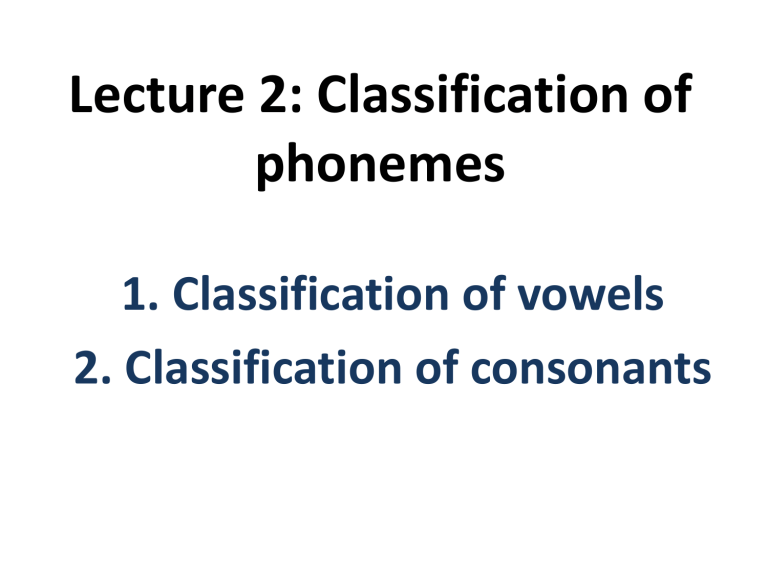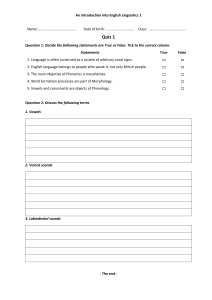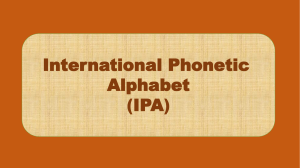
Lecture 2: Classification of phonemes 1. Classification of vowels 2. Classification of consonants You will get to know today: • Monophthongs • Diphthongs • Diphthongoids Questions: • 1. What is the difference between front and frontretracted vowels? • 2. What is the difference between back and backadvanced vowels? • 3. What makes central and front vowels different? • 4. Are there any historically long and short vowels in English? Classification of vowels • How many vowels are there in the English language? Vowels are classified by: • 1. the stability of articulation; • 2. the tongue position; • 3. the lip position; • 4. the vowel length. The stability of articulation criterion of vowel classification Monophthongs • Monophthongs are vowels the articulation of which is almost unchanging, quality of such vowels is relatively pure. 10 vowels / monophthongs • [ɪ], • [ɒ], [ɔ:], • [ʌ], [a:], • [ʊ], • [e], [æ], • [ə], [ə:] Diphthongs • In the pronunciation of diphthongs the organs of speech glide from one vowel position to another within one syllable. The starting point, the nucleus, is strong and distinct. The glide which shows the direction of the quality change is very weak. In fact diphthongs consist of two clearly perceptible vowel elements. • • • • • • • • [eɪ], [aɪ], [ɔɪ], [ɪə], [εə], [uə], [au], [əu] 8 diphthongs Diphthongoids • In the pronunciation of diphthongoids the articulation is slightly changing but the difference between the starting point and the end is not so distinct as it is in the case of diphthongs. • There are two diphthongoids in English: [i:, u:]. The tongue position criterion of vowel classification Front vowels • When the tongue moves in the horizontal direction various parts of it may be raised in the direction of the palate. • When the tongue is in the front part of the mouth and the front part of it is raised to the hard palate a front vowel is pronounced. • This is the position for the English vowels [i:], [e], [æ]. Front-retracted vowel • When the tongue is in the front part of the mouth but slightly retracted, and the part of the tongue nearer to centre than to front is raised, a front-retracted vowel is pronounced. The English vowel [ɪ]. Central vowels • When the front of the tongue is raised towards the back part of the hard palate the vowel is called central. • This is the position for the English vowels [ʌ], [ə], [ə:]. Back vowels • When the tongue is in the back part of the mouth and the back of it is raised towards the soft palate a back vowel is pronounced. • This is the position for the English vowels [ɒ], [ɔ:], [u:]. Back-advanced vowel • When the tongue is in the back part of the mouth but is slightly advanced and the central part of it is raised towards the front part of the soft palate a back-advanced vowel is pronounced. • This is the position for the English vowel [ʊ] The lip position criterion of vowel classification Lip position criterion • When the lips are • When the lips are neutral or spread the drawn together so vowels are that the opening termed unrounded. between them is more or less round • [ɪ], [i:], [ɒ], [ʌ], [a:], the vowel is [e], [æ], [ə], [ə:]. called rounded. • [ɒ], [ɔ:], [ʊ], [u:]. The vowel length criterion of vowel classification Short and Long vowels • Vowels are capable of being continued during a longer or a shorter period. • All English vowels (with the exception of diphthongs) are generally divided into long and short. Short and long vowels • Long vowels • [i:], [a:], [ɔ:], [u:], [ə:] • [æ] • Short vowels • [ɪ], [e], [ʌ], [ɒ], [ʊ], [ə]. Classification of consonants The term of the consonant • A consonant is a sound in spoken language that is characterized by a constriction or closure at one or more points along the vocal tract, such as the lips, tongue and teeth. Criteria for consonants classification • 1. The degree of noise. • 2. The manner of articulation. • 3. The place of articulation. The degree of noise criterion of consonants classification The degree of noise • According to the degree of noise English consonants are divided into two big classes: • Class A: Noise consonants • Class B:Sonorants Noise consonant sounds vary: • (1) In the •(2) in the work of the degree of vocal cords force of articulation Voiceless and voiced consonants • When the vocal • If the vocal cords cords are brought are apart and do together and not vibrate we vibrate we hear hear only noise voice. • Voiceless • Voiced consonants [p, t, consonants [b, d, k, s, f, h, ∫, t∫, θ]. g, z, v, ð, ʒ, dʒ]. B.Sonorants (or sonorous consonants) • B.Sonorants (or sonorous consonants) are made with tone prevailing over noise because of a rather wide air passage. •[m, n, ŋ, w, r, l, j]. The manner of articulation criterion of consonants classification Complete and incomplete obstruction • The manner of articulation of consonants is determined by the type of obstruction. The obstructions may be complete and incomplete. • When the obstruction is complete the organs of speech are in contact and the air stream meets a closure in the mouth or nasal cavities as in the production of the English [p, b, t, d, k, g, t∫, dʒ, m, n, ŋ]. Incomplete obstruction • In case of an incomplete obstruction the active organ of speech moves towards the point of articulation and the air stream goes through the narrowing between them as in the production of the English [f, ð, ∫,ʒ,h, w, 1, r, j]. v, s, z, θ, The manner of articulation • 1. Occlusive. • 2. Constrictive. • 3. Occlusive-constrictive (affricates). Occlusive consonants • are sounds in the production which the air stream meets a complete obstruction in mouth. • Occlusive noise consonants are called stops because the breath is completely stopped at some point articulation and then it is released with a slight explosion, that is why, they are also called plosives. • According to the work of the vocal cords stops may be voiced and voiceless. Occlusive voiced and voiceless consonants • Occlusive voiced consonants are: [b, d, g]. • Occlusive voiceless consonants are: [p, t, k]. Occlusive sonorants • are also made with a complete obstruction but the soft palate is lowered and the air stream escapes through the nose, so they are nasal. • [m, n, ŋ]. Constrictive consonants • are those in the production of which the air stream meets an incomplete obstruction in the resonator, so the air passage is constricted. • Both noise consonants and sonorants may be constrictive. Constrictive noise consonants / fricatives • the consonant sounds in the articulation of which the air passage is constricted and the air escapes through the narrowing with friction. • [f, v, θ, ð, ∫, ʒ, h] Voiced and voiceless fricatives • voiced fricatives: • [v, ð, z, ʒ] • voiceless fricatives: • [f, θ, s, ∫, h] Constrictive sonorants • are also made with an incomplete obstruction but with a rather wide air passage; so tone prevails over noise. • constrictive sonorants: [w, r, l, j]. • They are all oral, because in their production the soft palate is raised. Occlusive-constrictive consonants / affricates • or are noise consonant sounds produced with a complete obstruction which is slowly released and the air escapes from the mouth with some friction. • [t∫, dʒ].The English [dʒ] is voiced and [t∫] is voiceless. • Affricates are oral according to the position of the soft palate. The place of articulation criterion of consonants classification The place of articulation criterion • According to the position of the active organ of speech against the point of articulation (i. e. the place of articulation) consonants may be: • 1. Labial. • 2. Lingual. • 3. Glottal. 1. Labial consonants • are made by the lips. They may be bilabial and labio-dental. Bilabial consonants are produced when both lips are active. • [p, b, m, w]. • Labio-dental consonants are articulated with the lower lip against the edge of the upper teeth. • [f, v]. 2. Lingual consonants • are classified into forelingual, mediolingual and backlingual. • Forelingual consonants are articulated with the tip or the blade of the tongue. • According to the place of obstruction forelingual consonants may be: • interdental; • alveolar; • post-alveolar; • palato-alveolar Forelingual consonants • Interdental consonants are made with the tip of the tongue projected between the teeth: the English [θ, ð]. • Alveolar consonants are articulated with the tip against the upper teeth ridge: the English [t, d, s, z, n, l]. • Post-alveolar consonants are made when the tip or the blade of the tongue is against the back part of the teeth ridge or just behind it: the English [r]. Palato-alveolar consonants • are made with the tip or the blade of the tongue against the teeth ridge and the front part of the tongue raised towards the hard palate, thus having two places of articulation or foci (front secondary focus): • [∫, ʒ, t∫, dʒ]. Mediolingual consonants • are produced with the front part of the tongue. They are always palatal. Palatal consonants or palatals are made with the front part of the tongue raised high to the hard palate: the English [j]. Backlingual consonants • are also called velar, because they are produced with the back part of the tongue raised towards the soft palate (Lat. velum). • [k, g, ŋ]. 3. The glottal consonant • [h] is articulated in the glottis. Questions: • 1. What is the difference between front and frontretracted vowels? • 2. What is the difference between back and backadvanced vowels? • 3. What makes central and front vowels different? • 4. What characteristic makes close vowels unlike mid and open ones? • 5. Are there any historically long and short vowels in English? Thank you!






